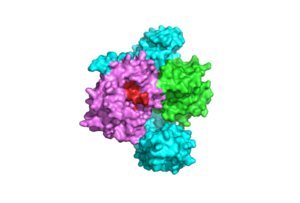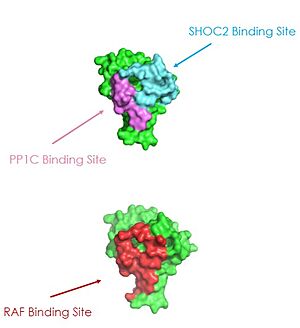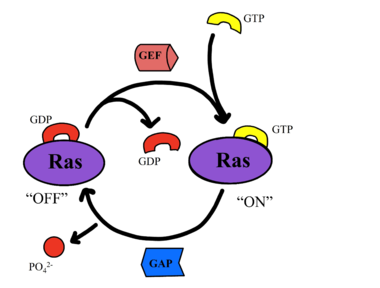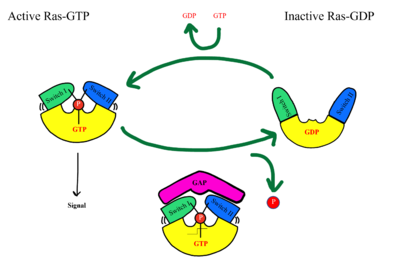Sandbox Reserved 1767
From Proteopedia
(Difference between revisions)
| Line 20: | Line 20: | ||
=== PP1C === | === PP1C === | ||
[[Image:CS.png|300 px|right|thumb|'''Figure 2:''' Catalytic Site of PP1C (PDB 7DSO) <ref name="Liau">PMID: 35768504</ref>.]] | [[Image:CS.png|300 px|right|thumb|'''Figure 2:''' Catalytic Site of PP1C (PDB 7DSO) <ref name="Liau">PMID: 35768504</ref>.]] | ||
| - | <scene name='95/952695/Pp1cintro/3'>The Protein Phosphatase Complex 1 (PP1C)</scene> subunit contains the catalytic site of the SMP complex. PP1C is a [https://pubmed.ncbi.nlm.nih.gov/30036567/. Phosphatase] enzyme responsible for the removal of a phosphate group on the N-terminal phosphoserine (NTpS) of RAF (Ser259)<ref name="Liau">PMID: 35768504</ref>. The exact mechanism of dephosphorylation is currently unknown, but there are three catalytic metal ions: 2 Mn⁺² and 1 Cl⁻¹ present that coordinate [https://www.ncbi.nlm.nih.gov/pmc/articles/PMC3458771/. nucleophilic] water molecules in the active site <ref name="Hauseman">PMID:35830882</ref>. This dephosphorylation event allows for pathway activation <ref name="Liau">PMID: 35768504</ref>. Although PP1C can dephosphorylate other proteins independently from the SMP complex, it cannot act on RAF unless bound to the complex because it lacks intrinsic substrate selectivity <ref name="Liau">PMID: 35768504</ref>. SHOC2 and MRAS aid in the specificity of the enzymatic activity. PP1C binds to SHOC2 and MRAS-GTP in a specific orientation that doesn’t change the conformation of the catalytic site and leaves it accessible for substrate binding as shown in '''Figure 2''' in red. | + | <scene name='95/952695/Pp1cintro/3'>The Protein Phosphatase Complex 1 (PP1C)</scene> subunit contains the catalytic site of the SMP complex. PP1C is a [https://pubmed.ncbi.nlm.nih.gov/30036567/. Phosphatase] enzyme responsible for the removal of a phosphate group on the N-terminal phosphoserine (NTpS) of RAF (Ser259)<ref name="Liau">PMID: 35768504</ref>. The exact mechanism of dephosphorylation is currently unknown, but there are three catalytic metal ions: 2 Mn⁺² and 1 Cl⁻¹ present that coordinate [https://www.ncbi.nlm.nih.gov/pmc/articles/PMC3458771/. nucleophilic] water molecules in the active site <ref name="Hauseman">PMID:35830882</ref>. This dephosphorylation event allows for pathway activation <ref name="Liau">PMID: 35768504</ref>. Although PP1C can dephosphorylate other proteins independently from the SMP complex, it cannot act on RAF unless bound to the complex because it lacks intrinsic substrate selectivity <ref name="Liau">PMID: 35768504</ref>. SHOC2 and MRAS aid in the specificity of the enzymatic activity. PP1C binds to SHOC2 and MRAS-GTP in a specific orientation that doesn’t change the conformation of the {{Font color|red|catalytic site}} and leaves it accessible for substrate binding as shown in '''Figure 2''' in red. |
PP1C binds to SHOC2 through a hydrophobic N-terminal disordered region that is complimentary to the <scene name='95/952695/Rvxf_motif/2'>RVXF Motif on SHOC2</scene> and adjacent to a catalytic metal ions <ref name="Liau">PMID: 35768504</ref>. In the RAS/RAF signaling cascade, the region of RAF that is C-terminal to the phosphate group binds to this hydrophobic groove, and the remaining residues bind to the hydrophobic region of SHOC2 <ref name="Hauseman">PMID:35830882</ref>. RAF binding to this region of SHOC2 is what allows PP1C to be specific when in the SMP complex in comparison to PP1C on its own <ref name="Hauseman">PMID:35830882</ref>. Similarly to SHOC2, PP1C does not undergo a <scene name='95/952694/Pp1coverlay/4'>significant conformational change</scene> when SHOC2 and MRAS-GTP bind. The lack of conformational change shows that the structure of PP1C is not dependent on the SMP complex, but in order to act as a phosphatase it must be bound to the complex <ref name="Liau">PMID: 35768504</ref>. | PP1C binds to SHOC2 through a hydrophobic N-terminal disordered region that is complimentary to the <scene name='95/952695/Rvxf_motif/2'>RVXF Motif on SHOC2</scene> and adjacent to a catalytic metal ions <ref name="Liau">PMID: 35768504</ref>. In the RAS/RAF signaling cascade, the region of RAF that is C-terminal to the phosphate group binds to this hydrophobic groove, and the remaining residues bind to the hydrophobic region of SHOC2 <ref name="Hauseman">PMID:35830882</ref>. RAF binding to this region of SHOC2 is what allows PP1C to be specific when in the SMP complex in comparison to PP1C on its own <ref name="Hauseman">PMID:35830882</ref>. Similarly to SHOC2, PP1C does not undergo a <scene name='95/952694/Pp1coverlay/4'>significant conformational change</scene> when SHOC2 and MRAS-GTP bind. The lack of conformational change shows that the structure of PP1C is not dependent on the SMP complex, but in order to act as a phosphatase it must be bound to the complex <ref name="Liau">PMID: 35768504</ref>. | ||
| Line 34: | Line 34: | ||
RAS proteins are GTP-dependent [https://pubmed.ncbi.nlm.nih.gov/14604583/. intracellular switches] that are anchored to the plasma membrane. <ref name="Liau">PMID: 35768504</ref> RAS proteins activate RAF kinases through direct binding and membrane recruitment, resulting in RAF dimerization and pathway activation <ref name="Liau">PMID: 35768504</ref>. The SMP complex has specificity for MRAS. Other RAS proteins may bind to SHOC2, but MRAS induces the complex formation with a significantly lower [https://www.ncbi.nlm.nih.gov/pmc/articles/PMC6004624/. dissociation constant] <ref name="Liau">PMID: 35768504</ref>. There are no known membrane interacting regions on SHOC2 and PP1C, meaning the [https://bio.libretexts.org/Bookshelves/Introductory_and_General_Biology/Book%3A_General_Biology_(Boundless)/03%3A_Biological_Macromolecules/3.05%3A_Lipid_Molecules_-_Phospholipids#:~:text=The%20fatty%20acid%20chains%20are,the%20intracellular%20and%20extracellular%20fluid. hydrophobic fatty acid tail] on MRAS is responsible for recruiting the complex to the cell membrane allowing only for 2D movement and increasing local concentrations of the players needed in this signaling pathway <ref name="Hauseman">PMID:35830882</ref>. | RAS proteins are GTP-dependent [https://pubmed.ncbi.nlm.nih.gov/14604583/. intracellular switches] that are anchored to the plasma membrane. <ref name="Liau">PMID: 35768504</ref> RAS proteins activate RAF kinases through direct binding and membrane recruitment, resulting in RAF dimerization and pathway activation <ref name="Liau">PMID: 35768504</ref>. The SMP complex has specificity for MRAS. Other RAS proteins may bind to SHOC2, but MRAS induces the complex formation with a significantly lower [https://www.ncbi.nlm.nih.gov/pmc/articles/PMC6004624/. dissociation constant] <ref name="Liau">PMID: 35768504</ref>. There are no known membrane interacting regions on SHOC2 and PP1C, meaning the [https://bio.libretexts.org/Bookshelves/Introductory_and_General_Biology/Book%3A_General_Biology_(Boundless)/03%3A_Biological_Macromolecules/3.05%3A_Lipid_Molecules_-_Phospholipids#:~:text=The%20fatty%20acid%20chains%20are,the%20intracellular%20and%20extracellular%20fluid. hydrophobic fatty acid tail] on MRAS is responsible for recruiting the complex to the cell membrane allowing only for 2D movement and increasing local concentrations of the players needed in this signaling pathway <ref name="Hauseman">PMID:35830882</ref>. | ||
| - | A significant amount of steric overlap is seen in MRAS for the binding sites of PP1C, SHOC2, and RAF <ref name="Liau">PMID: 35768504</ref>. In '''Figure 3''', {{Font color|lime|MRAS}} is shown in green, with the {{Font color|cyan|SHOC2 | + | A significant amount of steric overlap is seen in MRAS for the binding sites of PP1C, SHOC2, and RAF <ref name="Liau">PMID: 35768504</ref>. In '''Figure 3''', {{Font color|lime|MRAS}} is shown in green, with the {{Font color|cyan|SHOC2 binding site}} colored cyan, the {{Font color|violet|PP1C binding site}} colored violet, and the {{Font color|red|RAF binding site}} shown in red on a different RAS protein. Hence, multiple RAS proteins are required for further activation of the receptor tyrosine kinase pathway <ref name="Lavoie">PMID: 35970881</ref>. Due to the significant overlap in binding domains, one MRAS molecule is needed to recruit SHOC2 and PP1C to the membrane, and another RAS molecule is needed activate RAF <ref name="Lavoie">PMID: 35970881</ref>. The ability of MRAS-GTP to cluster at the cell membrane is a crucial capability for this protein complex. The presence of this <scene name='95/952695/413cellmemprotrusion/4'>palmitoylated tail</scene> is responsible for this anchoring to the cell membrane, similar to the hydrophobic fatty acid tail on MRAS that is responsible for recruiting SMP to the cell membrane. |
| Line 44: | Line 44: | ||
[[Image:RASRAF.png|410 px|right|thumb|'''Figure 5''': MRAS SWI and SWII open and closed conformations<ref name="Liau">PMID: 35768504</ref>.]] | [[Image:RASRAF.png|410 px|right|thumb|'''Figure 5''': MRAS SWI and SWII open and closed conformations<ref name="Liau">PMID: 35768504</ref>.]] | ||
| - | SHOC2-PP1C-MRAS is a central gatekeeper in receptor tyrosine kinase signaling <ref name="Liau">PMID: 35768504</ref>. '''Figure 1''' shows the specific pathways SHOC2-PP1C-MRAS mediates. When MRAS is bound to GDP, shown in the left of '''Figure 1''', RAF is bound to a 14-3-3 protein dimer restricting it to the cytoplasm. When MRAS-GDP is exchanged for GTP via a nucleotide exchange factor GEF, shown in '''Figure 4''', a conformational change occurs. This change | + | SHOC2-PP1C-MRAS is a central gatekeeper in receptor tyrosine kinase signaling <ref name="Liau">PMID: 35768504</ref>. '''Figure 1''' shows the specific pathways SHOC2-PP1C-MRAS mediates. When MRAS is bound to GDP, shown in the left of '''Figure 1''', RAF is bound to a 14-3-3 protein dimer restricting it to the cytoplasm. When MRAS-GDP is exchanged for GTP via a nucleotide exchange factor GEF, shown in '''Figure 4''', a conformational change occurs. This change causes a shift from the <scene name='95/952693/Swi_open_conformation/6'>open conformation</scene> to <scene name='95/952693/Switch_i_gtp_bound/11'>closed conformation</scene> of Switch I, shown in '''Figure 5'''. The Switch I (SWI) region is made up of residues 42-48 of the MRAS domain <ref name="Kwon">PMID: 35831509</ref>. These residues are crucial for the binding of MRAS, SHOC2, and PP1C because MRAS undergoes a conformational change that allows for SMP complex assembly upon GTP binding <ref name="Hauseman">PMID:35830882</ref>. When GTP is bound to MRAS, it is in the “closed conformation” because hydrogen bond interactions between the γ phosphate of GTP and residues in the SWI region of MRAS cause SWI to adopt a closed conformation <ref name="Hauseman">PMID:35830882</ref>, as seen in '''Figure 5'''. The closed conformation allows for the binding of SHOC2 and PP1C because there is no [https://www.ncbi.nlm.nih.gov/pmc/articles/PMC3058769/. steric clash] between the <scene name='95/952693/Switch_i_gtp_bound/11'>SWI region of MRAS</scene> and the surface of SHOC2 when GTP is bound <ref name="Kwon">PMID: 35831509</ref>. The only large-scale conformational change occurs in the MRAS subunit <ref name="Liau">PMID: 35768504</ref>. When GDP is bound to the MRAS domain, it is in the “open” conformation. Since the γ-phosphate is not bound to GDP, there are no hydrogen bond interactions with the oxygens of the γ-phosphate group and the MRAS SWI region, causing MRAS to adpot an "open" conformation. Since SHOC2 and PP1C do not undergo much conformational change, they are in a slow equilibrium of binding and unbinding until MRAS binds to GTP allowing MRAS to bind to SHOC2 and PP1C <ref name="Liau">PMID: 35768504</ref>. |
=== Cancer and Rasopathies === | === Cancer and Rasopathies === | ||
Revision as of 03:48, 17 April 2023
| This Sandbox is Reserved from February 27 through August 31, 2023 for use in the course CH462 Biochemistry II taught by R. Jeremy Johnson at the Butler University, Indianapolis, USA. This reservation includes Sandbox Reserved 1765 through Sandbox Reserved 1795. |
To get started:
More help: Help:Editing |
SHOC2-PP1C-MRAS
| |||||||||||
References
- ↑ 1.0 1.1 1.2 1.3 1.4 1.5 1.6 1.7 Kwon JJ, Hajian B, Bian Y, Young LC, Amor AJ, Fuller JR, Fraley CV, Sykes AM, So J, Pan J, Baker L, Lee SJ, Wheeler DB, Mayhew DL, Persky NS, Yang X, Root DE, Barsotti AM, Stamford AW, Perry CK, Burgin A, McCormick F, Lemke CT, Hahn WC, Aguirre AJ. Structure-function analysis of the SHOC2-MRAS-PP1C holophosphatase complex. Nature. 2022 Jul 13. pii: 10.1038/s41586-022-04928-2. doi:, 10.1038/s41586-022-04928-2. PMID:35831509 doi:http://dx.doi.org/10.1038/s41586-022-04928-2
- ↑ 2.00 2.01 2.02 2.03 2.04 2.05 2.06 2.07 2.08 2.09 2.10 Hauseman ZJ, Fodor M, Dhembi A, Viscomi J, Egli D, Bleu M, Katz S, Park E, Jang DM, Porter KA, Meili F, Guo H, Kerr G, Molle S, Velez-Vega C, Beyer KS, Galli GG, Maira SM, Stams T, Clark K, Eck MJ, Tordella L, Thoma CR, King DA. Structure of the MRAS-SHOC2-PP1C phosphatase complex. Nature. 2022 Jul 13. pii: 10.1038/s41586-022-05086-1. doi:, 10.1038/s41586-022-05086-1. PMID:35830882 doi:http://dx.doi.org/10.1038/s41586-022-05086-1
- ↑ 3.00 3.01 3.02 3.03 3.04 3.05 3.06 3.07 3.08 3.09 3.10 3.11 3.12 3.13 3.14 3.15 3.16 3.17 3.18 3.19 3.20 3.21 3.22 3.23 Liau NPD, Johnson MC, Izadi S, Gerosa L, Hammel M, Bruning JM, Wendorff TJ, Phung W, Hymowitz SG, Sudhamsu J. Structural basis for SHOC2 modulation of RAS signalling. Nature. 2022 Jun 29. pii: 10.1038/s41586-022-04838-3. doi:, 10.1038/s41586-022-04838-3. PMID:35768504 doi:http://dx.doi.org/10.1038/s41586-022-04838-3
- ↑ 4.0 4.1 4.2 4.3 4.4 4.5 4.6 4.7 Lavoie H, Therrien M. Structural keys unlock RAS-MAPK cellular signalling pathway. Nature. 2022 Sep;609(7926):248-249. PMID:35970881 doi:10.1038/d41586-022-02189-7
- ↑ 5.0 5.1 Young LC, Hartig N, Boned Del Río I, Sari S, Ringham-Terry B, Wainwright JR, Jones GG, McCormick F, Rodriguez-Viciana P. SHOC2-MRAS-PP1 complex positively regulates RAF activity and contributes to Noonan syndrome pathogenesis. Proc Natl Acad Sci U S A. 2018 Nov 6;115(45):E10576-E10585. PMID:30348783 doi:10.1073/pnas.1720352115
- ↑ Kelker MS, Page R, Peti W. Crystal structures of protein phosphatase-1 bound to nodularin-R and tautomycin: a novel scaffold for structure-based drug design of serine/threonine phosphatase inhibitors. J Mol Biol. 2009 Jan 9;385(1):11-21. Epub 2008 Nov 1. PMID:18992256 doi:10.1016/j.jmb.2008.10.053
Student Contributors
- Sloan August
- Rosa Trippel
- Kayla Wilhoite





